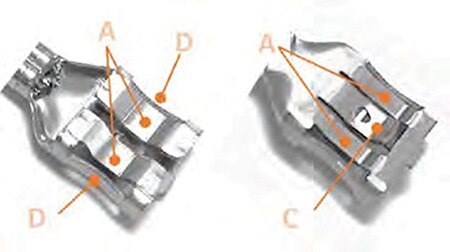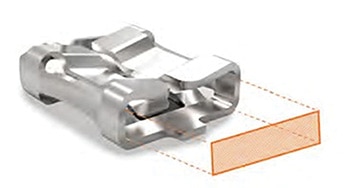F-Spring Contact FASTON Terminal
2016-03-24
TE Connectivity’s new F-spring contact FASTON terminal meets the highest quality and safety requirements for many applications in a wide variety of industries and markets.
Quick disconnects have been used by several different industries for more than 70 years. Billions of these terminals are in service today. Their applications range from appliances to automotive wire harnesses, and include high-temperature designs and electric motor and power supply controls. These terminals continue to be the standard for wiring electrical components since they remain unsurpassed in meeting the basic mechanical and electrical requirements of many applications. The reason for this product’s longevity is quite simple: appliance, automotive, lighting and many other industries need interconnect systems that are reliable and cost effective. Their popularity illustrates the intrinsic reliability of crimp connections.
Listening to the industry
Manufacturers using interconnect systems are focused on innovation in terms of quality upgrading and new product introductions. Regulations and standards are important drivers of innovation and also influence the materials used in manufacturing.
The demands for safer, more environmentally friendly products have resulted in consumers showing a willingness to pay for energy efficiency, with eco-labeling enabling them to choose “greener” products. At the same time, governments are encouraging functional incentives such as ENERGY STAR (U.S.), the EU Energy Labeling Directive (European Union), and the Energy Rating Label (Australia).
In addition to a broad range of environmental directives, product design is affected by provisions aimed at user safety. There are several regulations to prevent workplace injuries and improve ergonomics that affect basic product development. As a result, design has become a significant element to meet these requirements, in that a good design will lead to a safe design.
Reducing manufacturing costs while improving quality is another priority for manufacturers. In addition to costs from production or remedying failures, a significant factor is the cost of design.
A key element for improving product quality and manufacturability is mistake-proofing the initial design. A difficult-to-assemble product is more likely to be produced incorrectly. For this reason it is mandatory to find and correct defects caused by errors as close to the source as possible, since costs increase as a product or item flows through the manufacturing process. The benefits of mistake-proofing not only help with production, it can also help improve user operation, maintenance, and servicing.
For all of these reasons, establishing safe manufacturing processes and improving product reliability helps increase market share by forging better customer relationships.
The F-spring contact FASTON terminal
TE Connectivity’s (TE) new F-spring contact FASTON terminal offers a combination of low insertion force (LIF) and high performance to help meet the latest market trends and consumer requirements (Figure 1). F-spring terminals offer significant benefits and advantages compared to more traditional contacts.

Figure 1: Straight and flag versions with same mating area geometry.
Energy efficient
Thanks to its steel nickel material the F-spring contact can be used in many applications with a wide range of temperatures. Good performance against corrosion is another advantage as well as better mechanical resistance and improved capability of dynamic energy absorption.
In addition, the lower weight versus traditional copper alloys will bring to manufacturers the benefit of handling lighter harnesses. This contributes to meeting the target of realizing lightweight products for higher efficiency improvement.
Low insertion force (LIF)
The F-spring is an LIF contact, due to its leaf-spring rolls (A) on the top and bottom surface (Figure 2). The LIF feature results in easy insertion when mated with the tabs, according to UL310 and IEC61210 standards. Because the insertion force is below 35N, minimal effort is required by the operator during the assembly process. This design capability is highly advantageous since it helps improve user performance and product reliability.

Figure 2: Leaf-spring rolls, tab guidance features, and locking dimple shown.
Leaf-spring rolls in the mating area eliminate the typical profiled-edge contact. The F-spring contact’s flared lead-in and milled surface contribute to LIF (Figure 3). This design helps ease the assembly process – especially when mating tabs are located in difficult-to-reach areas.

Figure 3: Flared lead-in and milled surface with its low friction make for easier tab insertion.
Mistake-proof, reliable connections
To improve reliability and minimize mistakes during assembly, the F-spring contact FASTON terminal’s leaf-spring rolls provide high normal force in the contact areas. At the same time, they also exhibit good wiping action during contact engagement.
Another mistake-proofing feature is a locking dimple (C) on a cantilevered surface that functions as a safety device to keep the contacts in position and to prevent unintentional disconnection. When mated with the tab, an audible “click” helps the operator to confirm a proper connection.
In addition, tab guidance features (D) center the tab in the mating area to provide additional mechanical and electrical contact points. These features provide the following important reliability benefits:
- maintain mechanically stable contacts in the mated position
- extend the life of interconnections
- provide ruggedness and durability
Current ratings
The F-spring contact FASTON system offers a complete range of wire-termination capabilities. The straight version addresses wire sizes ranging from 24 to 10 AWG, and the flag version from 20 to 12 AWG. Contacts crimped onto the smallest 24 AWG wires can be used with current ratings up to 3 A and the maximum 20 A capability for 10 AWG wire applications. The F-Spring product’s high number of contact points provides higher stability than similar products on the market.
Summary
TE’s F-spring contact FASTON terminal addresses market, government and consumer demands for interconnects that are reliable, safe and energy efficient. Key features include better retention, insertion, and contact-stability benefits compared with similar solutions on the market. They also offer a wide temperature range and a small profile. These features make FASTON terminals suitable for many different quick-disconnect applications, including large and small appliances, power tools, electric motors, air conditioning, lighting, automotive, and high-temperature designs.
The ergonomic features of the terminals can help manufacturers provide safe and efficient assembly, which in turn results in end-product reliability and customer satisfaction.
免责声明:各个作者和/或论坛参与者在本网站发表的观点、看法和意见不代表 DigiKey 的观点、看法和意见,也不代表 DigiKey 官方政策。







 中国
中国